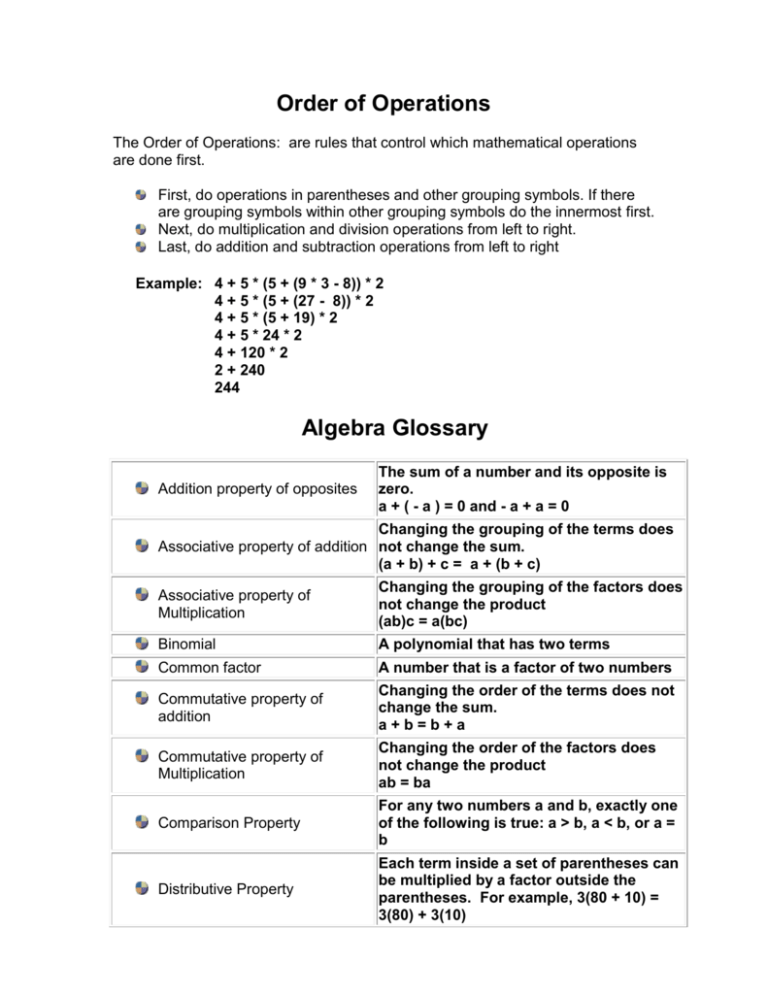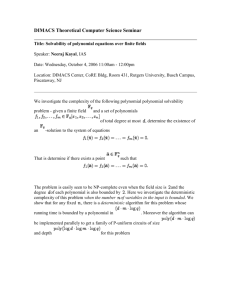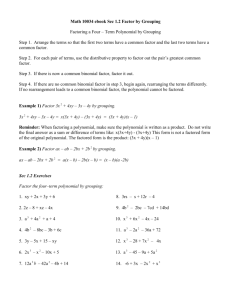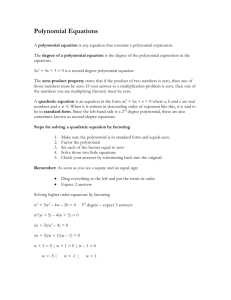order of operations & algebra glossary
advertisement

Order of Operations The Order of Operations: are rules that control which mathematical operations are done first. First, do operations in parentheses and other grouping symbols. If there are grouping symbols within other grouping symbols do the innermost first. Next, do multiplication and division operations from left to right. Last, do addition and subtraction operations from left to right Example: 4 + 5 * (5 + (9 * 3 - 8)) * 2 4 + 5 * (5 + (27 - 8)) * 2 4 + 5 * (5 + 19) * 2 4 + 5 * 24 * 2 4 + 120 * 2 2 + 240 244 Algebra Glossary Addition property of opposites The sum of a number and its opposite is zero. a + ( - a ) = 0 and - a + a = 0 Changing the grouping of the terms does Associative property of addition not change the sum. (a + b) + c = a + (b + c) Associative property of Multiplication Changing the grouping of the factors does not change the product (ab)c = a(bc) Binomial A polynomial that has two terms Common factor A number that is a factor of two numbers Commutative property of addition Changing the order of the terms does not change the sum. a+b=b+a Commutative property of Multiplication Changing the order of the factors does not change the product ab = ba Comparison Property For any two numbers a and b, exactly one of the following is true: a > b, a < b, or a = b Distributive Property Each term inside a set of parentheses can be multiplied by a factor outside the parentheses. For example, 3(80 + 10) = 3(80) + 3(10) Equation A statement that two numbers or two expressions are equal Factor When a whole number is divisible by a second whole number, the second number is a factor of the first Factor a polynomial Express a polynomial whose coefficients are whole numbers as the product of other polynomials whose coefficients are whole numbers Greatest common monomial factor of a polynomial The GCF of the terms of the polynomial Histogram A type of bar graph that is used to show frequencies Identity property of addition The sum of any number and zero is the original number. a + 0 = a Identity property of Multiplication The Product of any number and 1 is the original number. a x 1 = a Inequality A mathematical sentence that has an inequality symbol between two numbers or quantities. Mixed Expression The sum or difference of a polynomial and a rational expression Monomials An expression that is either a real number, a variable, or a product of a real number and one or more variables Multiplication property for equations For all real numbers a, b, and c; if a = b then ac = bc Multiplicative identity element The number that when multiplied by any real number a equals the number a. The multiplicative identity element is 1. Multiplicative inverses Two numbers whose product is 1. Open sentence Equations and inequalities that contain variables. Polynomial A monomial or the sum or difference of monomials. Polynomial equation An equation whose sides are both polynomials Prime Polynomial A polynomial that has no polynomial factors with integral coefficients except itself and 1 Properties of equality For all real numbers a, b, c: Reflexive: a = a; Symmetric: If a = b, then b=a Transitive: If a = b and b = c, then a = c. Properties of -1 for Multiplication For every real number a: -1 x a = - a and a x - 1 = -a Property of proportions In a proportion, the product of the means equals the product of the extremes. Reflexive property of equality For all real numbers a, a = a Relation A set of one or more ordered pairs Simultaneous equations Two (or more ) equations using the same variables. Slope of line The ratio of the change in y to the corresponding change in x between any two points on the line. For any two points on a line, (x1, y1) and (x2, y2); m = ( y2 - y1) / (x2 - x1) Slope-Intercept form A linear equation in the form y = mx + b, where m is the slope of the line and b is the y-intercept. Standard form of a linear equation An equation in the form Ax + By = C, where A, B, and C are integers and A and B are not both zero. Subtraction property for equations For all real numbers a, b, and c, if a = b, then a-c= b-c Subtraction property of equality For all real numbers a and b, if a = b then b=a Transitive property of equality For all real numbers a, b, and c, if a = b and b = c, then a = c. Tree Diagram A diagram used to show relationships in compound events Trinomial A polynomial with three terms Variable expression An expression that contains one or more variables. Zero-product Property For all real numbers a and b, if ab = 0, then a = 0 or b = 0 or both a and b = 0.








